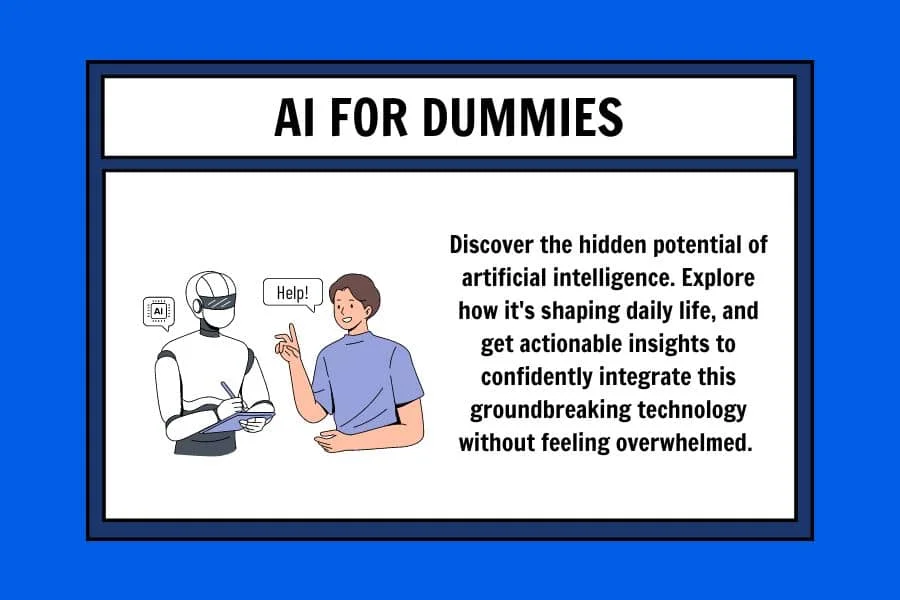Discover AI for dummies: Unravel the mysteries of artificial intelligence, learn its everyday applications, and gain practical tips to embrace this transformative technology without feeling overwhelmed.
Introduction
If you’re a solopreneur, entrepreneur, or someone looking to harness technology to grow your online business, this AI for dummies guide simplifies complex concepts so anyone can grasp them.
Imagine waking up in a world where your phone schedules your day, your fridge orders groceries, and your car drives you to work—all without you lifting a finger. Sounds like science fiction, right? Actually, it’s all powered by Artificial Intelligence (AI), and it’s not just for tech geniuses or massive corporations. Tech solutions like AI are quietly revolutionizing our everyday lives, and the best part? You don’t need a degree in computer science to understand or benefit from it.
AI has become a game-changer, but it’s often surrounded by intimidating jargon and complex concepts. That’s where this post comes in. We’ll break down AI in simple terms, showing you how to embrace it without feeling overwhelmed. Ready to dive in? Let’s start by unraveling the basics of AI.
Understanding AI Basics
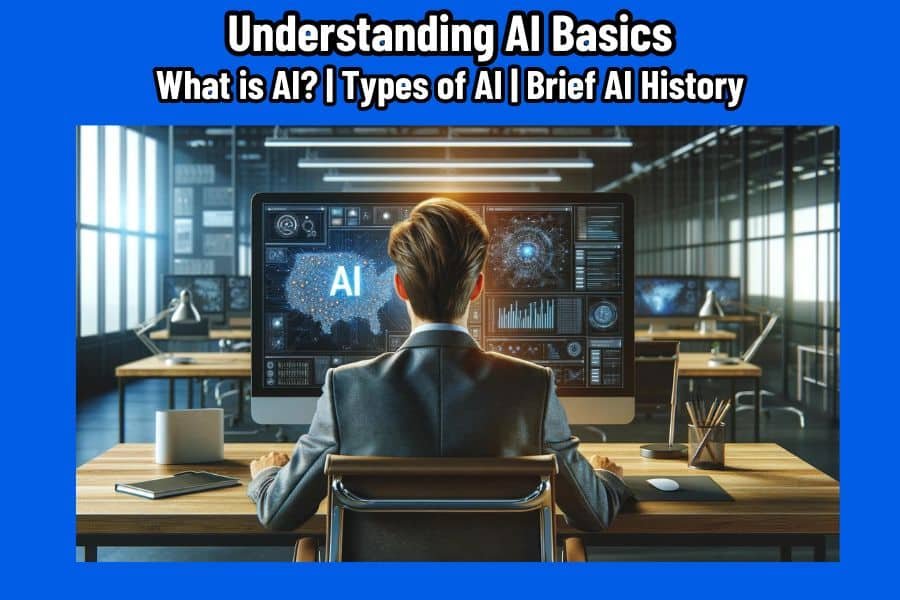
This AI for dummies section is a perfect starting point for beginners who want to understand the basics of artificial intelligence without feeling overwhelmed.
What is Artificial Intelligence?
Artificial Intelligence, or AI, refers to the development of computer systems capable of performing tasks that typically require human intelligence. These tasks range from recognizing speech and making decisions to solving complex problems and learning from experience. Simply put, AI allows machines to think and act in ways that mimic human behavior, but often with greater speed and accuracy. It’s not about replacing humans; it’s about enhancing how we interact with technology and the world around us.
For AI beginners, understanding the core concept of AI is essential. It’s more than just robotics or sci-fi fantasy. AI is already deeply integrated into everyday life, from virtual assistants like Siri and Alexa to personalized recommendations on Netflix and Amazon. By simplifying complex processes, AI allows businesses to streamline operations, improve customer experiences, and gain valuable insights. In short, it’s changing how we live and work—without us needing to understand every technical detail.
Types of AI: Narrow vs. General vs. Super AI
AI is not a one-size-fits-all technology; it comes in different types, each with its own capabilities. Narrow AI, also known as Weak AI, is the most common form today. It’s designed to perform a specific task—like playing chess, recommending products, or answering customer service inquiries. While incredibly efficient, Narrow AI is limited to its predefined functions and doesn’t possess the ability to learn or adapt beyond its programming.
On the other hand, General AI, or Strong AI, is still largely theoretical. This type of AI would have the ability to perform any intellectual task that a human can do, including emotional intelligence, creativity, and critical thinking. Lastly, Super AI is a futuristic concept where machines surpass human intelligence in all aspects. While this might sound exciting—or terrifying—Super AI remains a distant possibility. For now, businesses and individuals can benefit significantly from Narrow AI and the many applications it offers, with General and Super AI existing more in the realm of what might be possible in the future.
Brief History of AI Development
The development of Artificial Intelligence dates back to the 1950s when computer scientists first began to explore the possibility of machines thinking like humans. Alan Turing, one of the pioneers in the field, proposed the famous “Turing Test” to determine whether a machine could exhibit intelligent behavior indistinguishable from that of a human. This era marked the birth of AI, though early efforts were limited by the technology of the time. Fast forward to the 1980s, and the introduction of machine learning began to shift AI development into new realms, enabling machines to learn from data and improve performance over time.
The evolution of AI has been rapid in recent decades, especially with the advent of deep learning and the expansion of neural networks. Today, AI is at the forefront of technological innovation, playing a critical role in everything from healthcare and finance to retail and entertainment. Understanding where AI came from helps us appreciate how far it has come—and where it might go next. With each leap forward, AI is becoming more accessible to entrepreneurs, small business owners, and even hobbyists. Now that we’ve covered the basics, let’s demystify the AI jargon.
Demystifying AI Jargon
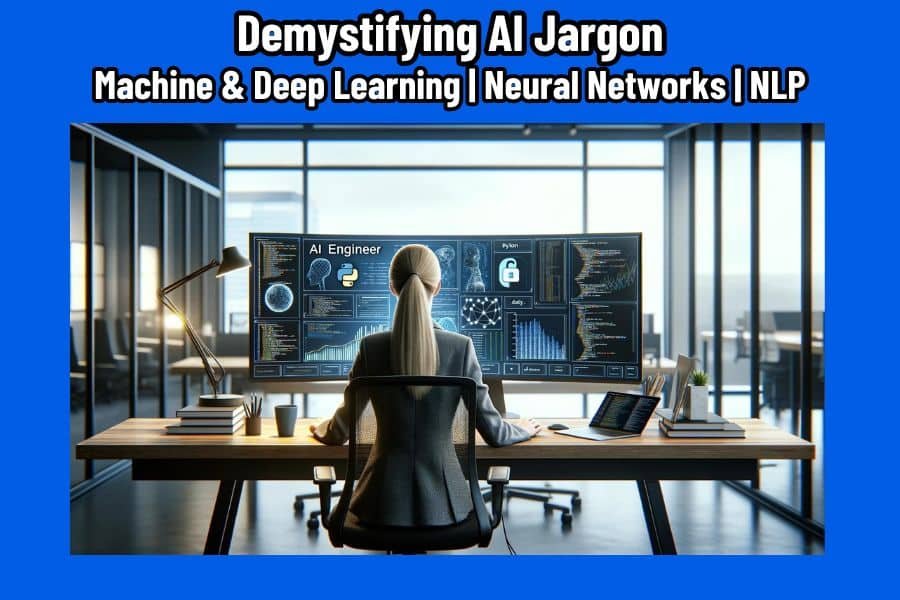
For those intimidated by all this AI jargon, in this AI for dummies section let’s break it down so it’s easier to understand.
Machine Learning vs. Deep Learning
One of the most common confusions in Artificial Intelligence basics is the difference between machine learning and deep learning. Both terms often get used interchangeably, but they refer to different approaches within AI. Machine learning is a subset of AI that enables systems to learn and improve from experience without being explicitly programmed. It works by feeding algorithms large amounts of data, which they then use to make predictions, recognize patterns, or automate decisions. For example, machine learning powers recommendation systems, like those used by Netflix or Amazon, by analyzing user preferences and predicting what you’d like next.
Deep learning, on the other hand, is a more advanced subset of machine learning that mimics the structure and function of the human brain. It uses neural networks with many layers (hence the term “deep”) to process vast amounts of data and solve more complex problems. While machine learning is excellent for tasks like spam detection or fraud prevention, deep learning excels at more intricate tasks, such as image recognition, voice assistants, and self-driving cars. The key difference lies in the depth of data analysis—deep learning allows machines to think and learn at a level much closer to human cognition. Now that we’ve tackled this distinction, let’s simplify another vital concept: neural networks.
Neural Networks Explained Simply
If the term neural networks sounds intimidating, think of it this way: a neural network is essentially a digital version of the human brain. Just like how our brains use neurons to process information, a neural network uses interconnected nodes (or “neurons”) to process and analyze data. These networks are designed to recognize patterns in data, making them particularly useful for tasks like image classification or language translation. For beginners in AI for dummies, it’s crucial to understand that neural networks help AI “learn” from data in ways that are not pre-programmed. Instead, the system adapts and improves as it processes more information.
The power of neural networks lies in their ability to break down complex problems into simpler, more manageable parts. For example, when a neural network analyzes a photo, it first identifies basic features like edges or colors, then combines that information to recognize objects or people. The deeper the network (with more layers of neurons), the more accurately it can perform tasks. This technology is at the heart of AI applications in business, powering everything from facial recognition software to recommendation systems. With neural networks demystified, let’s move on to another fascinating AI capability—Natural Language Processing (NLP).
Natural Language Processing (NLP) in Plain Terms
At its core, Natural Language Processing (NLP) is a branch of AI that focuses on enabling computers to understand, interpret, and respond to human language. Have you ever used a voice assistant like Siri or Google Assistant? That’s NLP in action. It allows machines to not only recognize the words you’re saying but also understand the context behind them. NLP powers everything from simple text-based chatbots to complex AI applications like automatic translation tools or speech recognition software. For entrepreneurs and business owners, NLP opens up new opportunities to engage customers through AI-powered customer service or marketing automation.
What makes NLP so impressive is that it’s constantly improving, learning to recognize the subtleties of language, like sarcasm or tone. This is especially important in AI applications in business, where customer interaction is key. For example, businesses can use NLP to analyze customer feedback, allowing them to understand sentiment and make data-driven decisions. And the best part? You don’t need to be a tech expert to leverage this technology; many AI tools for beginners now include easy-to-use NLP features. With these key AI concepts clarified, let’s explore some common applications of AI in everyday life.
AI in Everyday Life
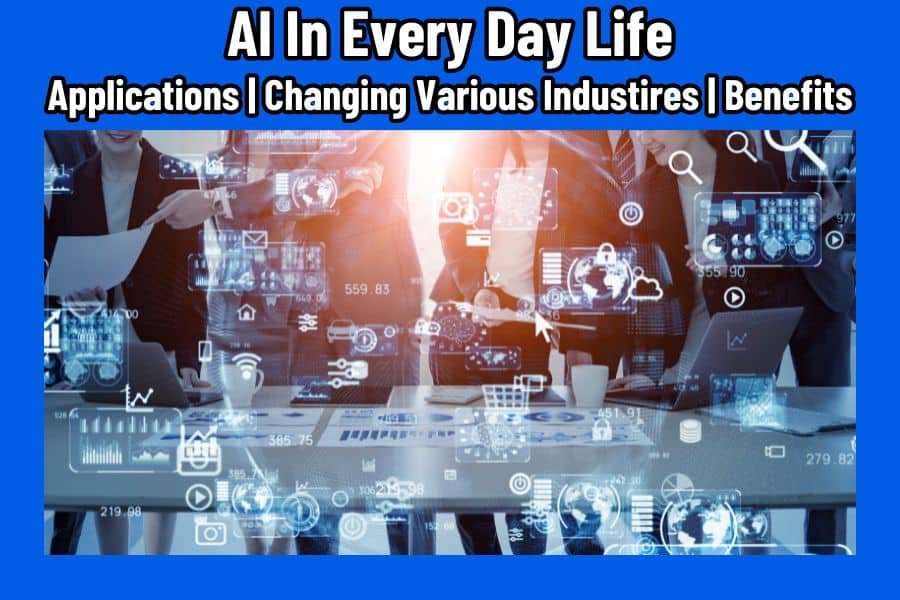
This AI for dummies section breaks down some common AI applications, industry changes, and benefits making it easier for entrepreneurs and small business owners to apply AI in their work.
Common AI Applications We Use Daily
You may not realize it, but Artificial Intelligence is already woven into the fabric of your daily life. Whether you’re using Google Maps to navigate, asking Alexa to play your favorite song, or scrolling through personalized social media feeds, AI is quietly working in the background. One of the most common AI applications is recommendation algorithms—think Netflix suggesting shows based on what you’ve already watched or Amazon predicting what you might want to buy next. These systems analyze your behavior and preferences, allowing businesses to deliver tailored experiences that save time and make life more convenient.
AI isn’t just limited to entertainment or shopping. It’s also present in tools like facial recognition on your smartphone, fraud detection for online banking, and even customer service chatbots that handle queries 24/7. AI-powered platforms are designed to simplify routine tasks, learning from data to improve accuracy and speed over time. For AI beginners, recognizing these everyday uses is a great way to start understanding how deeply AI is embedded in our lives without us even noticing.
How AI Is Changing Various Industries
AI is not just a behind-the-scenes player—it’s revolutionizing entire industries. In healthcare, AI assists doctors by analyzing medical images, predicting patient outcomes, and even helping develop new drugs faster than ever before. The finance industry uses AI tools for beginners and experts alike to detect fraud, optimize investment strategies, and automate customer service. AI’s predictive capabilities allow businesses to make informed decisions, reducing risk and enhancing efficiency.
Manufacturing is another sector being transformed by automation and AI. From optimizing supply chains to using robots in factories, AI reduces waste and increases productivity. Even in marketing, AI algorithms drive personalized campaigns, helping businesses target the right customers at the right time. The result? Faster processes, reduced human error, and greater scalability across industries. As AI continues to expand, its applications are becoming more accessible, leveling the playing field for entrepreneurs and small business owners eager to stay competitive. Now that we’ve seen AI’s industrial impact, let’s explore the benefits it brings to the average person.
Benefits of AI for the Average Person
For the average person, AI applications in business and daily life offer tangible benefits that can’t be ignored. One major advantage is convenience. Whether you’re using a virtual assistant to organize your schedule or leveraging AI-powered tools to improve your productivity, AI helps streamline tasks and free up your time. Imagine having a personal assistant that’s available 24/7, one that never gets tired and can handle everything from setting reminders to managing your emails. That’s what AI offers: the ability to automate mundane tasks so you can focus on what really matters.
AI also makes it easier to access information and learn new skills. With the rise of AI-powered apps for productivity and creativity, even those without technical backgrounds can use AI to enhance their workflows. Tools like Grammarly help improve writing, while Canva uses AI to assist in designing graphics. The simplicity of these platforms ensures that even AI for dummies (beginners) is no longer a far-fetched concept. These benefits empower individuals to work smarter, not harder, giving them more control over their time and resources. As we delve deeper into the world of AI, let’s break down some of the more technical jargon and simplify complex concepts, net let’s talk about overcoming AI anxiety.
Overcoming AI Anxiety
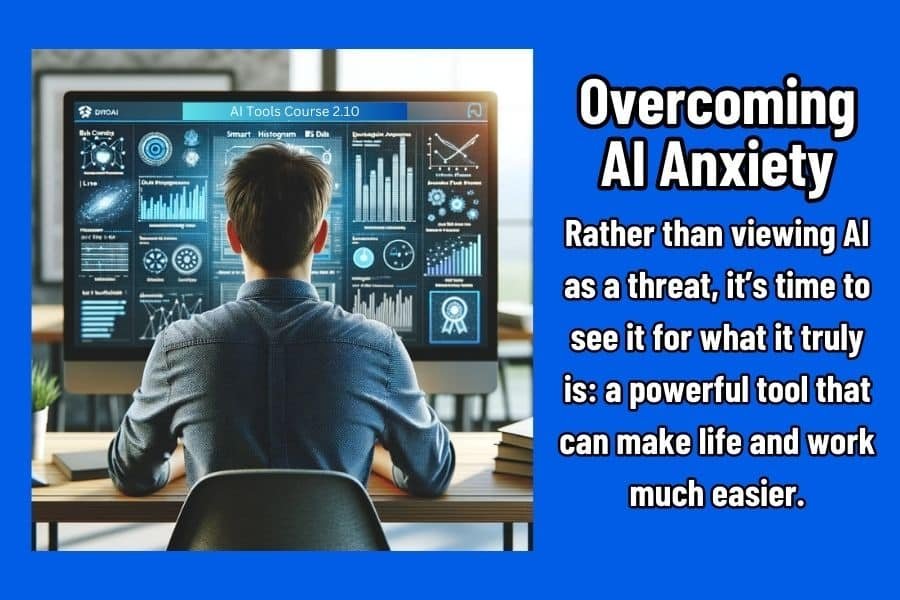
In this AI for dummies section, let’s talk about about how to address common fears about AI and why we need to embrace AI as a tool, not a threat.
Addressing Common Fears About AI
The rise of Artificial Intelligence has sparked many fears, particularly around job security and loss of human control. One of the most common fears is that AI will take over jobs, rendering certain roles obsolete. While it’s true that AI and automation will change the job landscape, it’s essential to understand that AI is more likely to augment human work rather than replace it entirely. For example, AI can handle repetitive tasks, freeing up time for humans to focus on creative, strategic, and interpersonal responsibilities that machines can’t replicate. This fear stems from misunderstanding the true role of AI, which is to complement and enhance human efforts, not to replace them.
Another common concern revolves around the fear of AI becoming too powerful, as portrayed in movies and media. The idea of machines developing their own consciousness and acting independently is far from the reality of AI tools for beginners and even advanced systems. Current AI is focused on narrow AI, designed for specific tasks and functions, and it lacks the ability to think or act outside of its programming. By addressing these fears and replacing myths with facts, entrepreneurs and small business owners can confidently explore how AI can positively impact their work and lives. The next step is to shift perspectives and embrace AI as a valuable tool.
Embracing AI as a Tool, Not a Threat
Rather than viewing AI as a threat, it’s time to see it for what it truly is: a powerful tool that can make life and work easier. AI enables small businesses to automate time-consuming tasks, increase productivity, and gain insights that would otherwise be out of reach. Imagine being able to automate customer service responses, personalize marketing campaigns, or analyze data trends with a few simple clicks. AI applications in business offer entrepreneurs the opportunity to scale their efforts without needing to invest in large teams or complex infrastructure. The key is to focus on how AI can assist, rather than replace, human efforts.
Embracing AI also means leveraging its ability to enhance human creativity and problem-solving. AI isn’t about doing everything for you; it’s about providing you with the tools to make better, faster decisions. Take content creation, for example. AI can help generate ideas or streamline workflows, but the creative vision still comes from the human mind. By using AI as a tool, entrepreneurs and small business owners can work smarter, not harder, and stay ahead in a competitive market. As we explore the synergy between humans and AI, let’s discuss how to balance the two effectively.
Balancing Human Skills with AI Capabilities
The real magic happens when humans and AI work together, each complementing the other’s strengths. While AI excels at processing large amounts of data, predicting trends, and automating repetitive tasks, human skills like creativity, emotional intelligence, and critical thinking remain irreplaceable. AI tools for beginners are designed to augment these human skills, allowing individuals to focus on areas where machines fall short. For example, while AI can analyze customer feedback and suggest improvements, only humans can truly understand the nuances of customer emotions and build strong, empathetic relationships.
Balancing human skills with AI capabilities is the key to future success. Entrepreneurs who can harness the efficiency of AI while leveraging their own creativity and intuition will be in the best position to thrive in an AI-driven world. By understanding where AI adds the most value and where human intervention is essential, businesses can create a harmonious blend of technology and human talent. As you navigate this balance, keep in mind that the future belongs to those who can embrace both AI and human skills. This balanced approach ensures sustainable growth and innovation, while still maintaining a human touch. Let’s explore next how you can get hands-on with AI through beginner-friendly tools and platforms.
Getting Started with AI: Tools, Platforms and Projects for Beginners

This AI for dummies section is designed to help non-techies harness the power of AI tools and platforms and complete simple projects in their businesses using AI.
User-Friendly AI Platforms and Apps for Non-Techies
Getting started with AI doesn’t require a technical background, thanks to a range of user-friendly AI tools and platforms that are designed for non-techies. These tools and platforms are simple, intuitive, and perfect for solopreneurs or small business owners looking to dip their toes into the world of AI without feeling overwhelmed.
- Systeme.io: A digital marketing platform designed to help entrepreneurs and small business owners automate their marketing funnels, manage email campaigns, and build websites. It integrates several tools into one user-friendly interface, making it accessible even for non-techies who want to streamline their marketing efforts without juggling multiple platforms.
- ChatGPT: Powered by OpenAI, ChatGPT is an AI chatbot that can generate human-like text based on user prompts. Whether you need help writing, brainstorming ideas, or automating customer service, this tool is incredibly easy to use, even if you’re new to AI.
- Canva: While known primarily as a graphic design tool, Canva now integrates AI to enhance its functionality. From generating design ideas to automating photo edits, Canva uses AI in a way that makes professional-quality designs accessible for anyone—no design skills required.
- AIVA: This AI music composer tool helps users create original soundtracks without needing to know anything about music production. It’s perfect for content creators and business owners looking to add custom music to their projects.
- DeepArt: If you’ve ever wanted to turn your photos into pieces of art, DeepArt is the tool for you. With just a few clicks, you can transform images into masterpieces, mimicking famous art styles using AI-powered neural networks.
- Midjourney: A creative AI platform that generates detailed images from text descriptions, Midjourney is excellent for non-designers who need custom visuals for blogs, websites, or presentations. Simply input a description, and Midjourney will generate high-quality images.
- Perplexity: This AI-powered search engine goes beyond simple keyword matching, offering more intuitive, context-driven search results. It’s great for entrepreneurs looking to dive deep into specific topics without sifting through irrelevant results.
- Microsoft Azure AI: Designed to be accessible for beginners, Azure AI offers a wide array of machine learning and AI tools that can help with everything from data analysis to building custom AI models. Its user-friendly interface makes it approachable even for non-tech users.
- Microsoft Power Automate: Automate repetitive tasks in your business using AI. Power Automate is designed to streamline workflows, automate responses, and connect various apps—all with minimal technical know-how.
- IBM Watson: Watson offers accessible AI-powered solutions, including chatbots and advanced analytics, making it easier for small business owners to harness the power of AI in customer service, marketing, and more.
- DataRobot: Perfect for non-technical users looking to leverage machine learning, DataRobot automates much of the data science process. Whether you’re predicting trends or optimizing workflows, DataRobot simplifies complex tasks.
- Appy Pie: Appy Pie allows users to build AI-powered apps without coding skills. It’s an excellent tool for entrepreneurs who want to develop custom apps for their business but don’t have the resources for a development team.
- Google Cloud AI Platform: Google’s AI platform offers a variety of pre-trained models for everything from speech recognition to image classification. Its simple interface makes it easy for non-technical users to integrate AI into their projects or businesses.
With these tools, anyone can start leveraging AI applications in business without needing an advanced degree or technical skills. Now, let’s explore some simple AI projects that will give you hands-on experience in using these tools and platforms effectively.
Simple AI Projects for Hands-On Learning
For solopreneurs and entrepreneurs, diving into AI applications in business can seem daunting, but there are plenty of simple projects that make the learning curve less steep. Here are seven projects that will not only teach you the basics of AI but also add real value to your business:
- Create a Lead Capture Page: One of the simplest yet most effective AI-driven projects is creating a lead capture page using Systeme.io. This all-in-one platform allows you to design and launch an optimized lead capture page without needing coding skills. The AI within Systeme.io helps you create engaging, high-converting pages that gather potential customer information like email addresses, which can then be automatically added to your email marketing list. This project is ideal for solopreneurs looking to grow their audience quickly and efficiently while leveraging AI to boost conversion rates.
- Create an AI-powered chatbot for customer service: Tools like ChatGPT or IBM Watson make it easy to build chatbots that can handle basic customer queries, improving response time and enhancing customer satisfaction.
- Generate content ideas with AI: Use platforms like ChatGPT or Perplexity to brainstorm blog topics, product descriptions, or social media posts. AI can help you overcome writer’s block and generate ideas tailored to your audience.
- Automate email marketing campaigns: Use Microsoft Power Automate or Appy Pie to create AI-driven workflows that send personalized emails based on customer behavior. This simple automation can save time while increasing engagement.
- Design branded visuals with AI: With tools like Canva or Midjourney, you can generate custom logos, social media graphics, and marketing materials that align with your brand—no design skills needed.
- Analyze customer feedback using sentiment analysis: Use Google Cloud AI Platform to analyze customer reviews and social media mentions to understand sentiment. This allows you to quickly identify areas for improvement or capitalize on positive feedback.
- Automate data entry and reporting: Tools like DataRobot or Microsoft Power Automate can help automate data collection and analysis, providing insights that guide business decisions without requiring manual data entry.
These beginner-friendly projects not only give you practical exposure to AI but also directly benefit your business, from improving productivity to enhancing customer interaction. Ready to explore the ethical considerations of AI and its impact? Let’s delve into that next.
AI Ethics and Considerations
This AI for dummies section is all about AI ethics including privacy, potential biases, responsible AI including potential risks of misusing AI, transparency and accountability.
Privacy Concerns in the Age of AI
As AI applications in business become more common, privacy concerns have emerged due to AI’s heavy reliance on data. Whether it’s personal preferences, browsing history, or facial recognition, AI collects vast amounts of user information to deliver personalized services and improve efficiency. However, this raises questions about how securely this data is stored and whether it’s being used ethically. Solopreneurs and small business owners must understand these privacy risks, especially when handling customer data.
The risk of data misuse or breaches is significant in an era of cyberattacks. Prioritizing user privacy is essential, with ethical AI development focusing on robust encryption, anonymization, and transparency. New AI users should select tools and platforms that emphasize data protection and clear privacy management guidelines, ensuring compliance with regulations like GDPR and CCPA. Now, let’s explore how AI biases can also impact business ethics.
Potential Biases in AI Systems
While AI trends in 2024 promise innovation, AI systems are still prone to human biases. These biases stem from the data used to train AI models, meaning biased data leads to biased outcomes. For instance, hiring algorithms can unintentionally exclude certain demographics due to historical biases in the data. Understanding machine learning and its limitations is critical for avoiding these pitfalls.
A key example is facial recognition technology, which has been found to be less accurate for people with darker skin tones, raising ethical concerns in law enforcement and hiring practices. Businesses must adopt AI tools tested on diverse data sets to reduce bias and ensure fair outcomes. Minimizing bias through responsible AI development is crucial for maintaining ethical standards. Now, let’s examine why responsible AI development is so important.
The Importance of Responsible AI Development
With innovation comes responsibility, and as businesses rely more on AI for decision-making, responsible AI development is essential. It’s not just about functionality; AI systems must be transparent, accountable, and fair. For solopreneurs and small business owners adopting AI tools for beginners, understanding the broader societal impact of AI is key.
Developers and businesses alike need to ensure their AI models are ethical, from how decisions are made to how they impact different user groups. Transparency and accountability are essential in maintaining customer trust. As AI trends continue to evolve, responsible development will play a critical role in ensuring AI benefits society fairly and equitably. Next, we’ll dive into the future trends in AI technology and their potential impact.
The Future of AI: What to Expect
There’s no doubt that AI is transforming industries and entrepreneurs must start leveraging AI for their own success. New technology is evolving daily. This section for AI for dummies we’ll take a deeper look into what to expect in the future. Such as emerging trends in AI technology, the potential impact to jobs and AI’s role in solving global business challenges.
Emerging Trends in AI Technology
As we look ahead, AI trends in 2024 are shaping up to be some of the most transformative yet. One of the key trends is the rise of Generative AI, which goes beyond mere automation to create new content, from text and images to music and video. This has huge implications for industries like marketing, entertainment, and even education, where AI-generated content can supplement human creativity. Another trend is the increased use of AI and automation in real-time decision-making, where algorithms analyze massive amounts of data in seconds to provide actionable insights in finance, healthcare, and logistics.
AI is also becoming more accessible to non-experts through user-friendly AI platforms and tools that allow small businesses to leverage AI without needing a team of data scientists. For example, AI tools for beginners, like no-code platforms, will continue to gain popularity, allowing entrepreneurs to integrate AI solutions quickly. This democratization of AI technology opens up opportunities for innovation in sectors that previously lacked access to such advanced tools. As these trends evolve, they promise to reshape how we approach business, creativity, and everyday life. With emerging technologies comes the question: what impact will AI have on jobs and the workforce?
Potential Impact on Jobs and the Workforce
AI’s potential to disrupt the workforce has sparked widespread debate. On the one hand, AI and automation are likely to displace jobs that involve repetitive or routine tasks. For example, roles in manufacturing, customer service, and even data entry are increasingly being handled by AI-powered systems. While this raises concerns about job loss, it’s important to recognize that AI is also creating new opportunities in fields like AI development, data analysis, and machine learning engineering. The demand for roles that support the development, implementation, and management of AI systems is on the rise, offering new career paths for those willing to adapt.
Additionally, AI is expected to augment human work rather than replace it entirely in many sectors. In healthcare, for instance, AI can assist doctors by analyzing medical data and providing diagnostic support, allowing professionals to focus on patient care rather than administrative tasks. In marketing, AI tools help optimize campaigns, but creativity and strategy still require human input. For solopreneurs and small business owners, embracing AI will mean finding ways to integrate these technologies into their workflows, freeing up time for higher-level, value-adding activities. As AI reshapes the workforce, let’s now look at how it plays a crucial role in solving global business challenges.
AI’s Role in Solving Global Business Challenges
One of the most promising aspects of AI applications in business is its ability to tackle some of the most complex challenges companies face globally. AI’s data-processing power enables businesses to optimize supply chains, improve customer service, and streamline operations at an unprecedented scale. For example, in logistics, AI helps companies predict demand, manage inventory, and reduce inefficiencies, ultimately leading to cost savings and faster delivery times. AI trends in 2024 also point to advancements in predictive analytics, where businesses can anticipate market changes and customer needs more accurately, allowing for proactive decision-making.
AI is also being used to address sustainability challenges. For instance, AI-powered tools help companies monitor energy consumption, reduce waste, and improve resource efficiency. In agriculture, AI can optimize crop yields by analyzing weather patterns and soil conditions, while in manufacturing, automation and machine learning are improving production efficiency with minimal environmental impact. These innovations not only help businesses stay competitive but also contribute to solving global challenges like climate change and food security. With AI offering such vast potential for change, the next step is to explore how we can stay informed and continue learning about this transformative technology.
Tips for Staying Informed About AI
In this AI for dummies section, we cover some important tips about AI and how to stay informed including reliable resources, courses and workshops, AI communities and forums.
Reliable Resources for AI News and Updates
- MIT Technology Review: This publication provides in-depth articles on cutting-edge advancements in Artificial Intelligence, including how AI is shaping industries like healthcare, finance, and education. It’s a must-read for staying informed on the future of AI.
- Wired: Wired offers easy-to-understand pieces on the latest AI trends and how they impact the workforce, business processes, and everyday life. It’s a great resource for entrepreneurs looking to stay competitive in an AI-driven world.
- Google AI Blog and OpenAI Research Blog: Both platforms dive deep into AI research, showcasing real-world applications, industry updates, and future possibilities. These resources are ideal for those who want specialized insights into how AI tools for beginners are evolving.
- Google Alerts: Set up alerts for AI trends in 2024 to get the latest news delivered directly to your inbox. It’s an easy way to stay updated on breakthroughs and applications that can impact your business.
Online Courses and Workshops for AI Beginners
- Coursera (AI for Everyone): Andrew Ng’s “AI for Everyone” course on Coursera is highly recommended for non-technical learners. It provides a clear and accessible introduction to AI basics, making it ideal for solopreneurs and small business owners.
- Udemy: Udemy offers a wide variety of AI courses, from AI for dummies to advanced topics like machine learning and neural networks. These courses are self-paced, allowing entrepreneurs to learn at their own speed.
- Google Cloud AI and Microsoft AI Workshops: These practical workshops often feature real-world case studies, showing how to integrate AI applications in business. Whether automating workflows or improving customer experience, these sessions are invaluable for entrepreneurs.
- EdX and LinkedIn Learning: Both platforms offer courses designed to help you understand how AI works and how to apply it. For beginners looking to implement AI into their businesses, these courses can be a great place to start.
Engaging with AI Communities and Forums
- AI Alignment Forum: This community is perfect for those interested in ethical AI development and exploring how AI can be developed responsibly. It offers a space to ask questions, share experiences, and engage with experts in the field.
- Reddit AI and Machine Learning Forums: These forums are beginner-friendly and offer regular updates on the latest AI tools, tutorials, and use cases. They’re great places for solopreneurs to ask for advice, learn from others’ experiences, and troubleshoot AI-related issues.
- Kaggle: Kaggle is a community where AI enthusiasts and professionals share data science projects, tutorials, and datasets. For those looking to take their knowledge further, Kaggle provides opportunities to practice simple AI concepts through competitions.
- Stack Exchange (AI Section): Stack Exchange has an active AI section where users discuss everything from coding AI algorithms to solving specific AI challenges. It’s a valuable resource for those looking to dive deeper into AI development and applications.
Engaging in these communities not only keeps you connected with the latest advancements but also provides practical ways to apply AI in your business. Now that you’re plugged into resources, courses, and communities, it’s time to tackle some common FAQs.
FAQs: AI for Dummies
FAQ 1: What is AI and why should I care about it?
Answer AI for Dummies:
AI, or Artificial Intelligence, refers to computer systems that can perform tasks typically requiring human intelligence, such as understanding language or recognizing patterns. As a solopreneur, leveraging AI can help automate repetitive tasks, improve customer engagement, and make data-driven decisions, ultimately saving you time and enhancing your business.
FAQ 2: How can AI benefit my small business?
Answer AI for Dummies:
AI can benefit your small business in many ways, including automating customer service through chatbots, analyzing customer data for better marketing strategies, and optimizing inventory management. These applications can help you operate more efficiently and focus on growth.
FAQ 3: Do I need to be tech-savvy to use AI tools?
Answer AI for Dummies:
No, you don’t need to be tech-savvy! Many AI tools are designed for users with little to no technical background. Platforms like chatbots and social media scheduling tools often come with user-friendly interfaces and tutorials to help you get started easily.
FAQ 4: What are some simple AI tools I can start using today?
Answer AI for Dummies:
Some simple AI tools you can start using include Grammarly for writing assistance, Canva for graphic design, and Hootsuite for social media management. These tools can help streamline your workflow and enhance your marketing efforts without requiring extensive technical knowledge.
FAQ 5: Are there ethical concerns I should be aware of when using AI?
Answer AI for Dummies:
Yes, there are ethical concerns, such as data privacy and potential biases in AI algorithms. As a business owner, it’s important to choose AI tools that prioritize user privacy and ensure that your use of AI aligns with ethical standards to build trust with your customers.
FAQ 6: How can I stay updated on AI trends and developments?
Answer AI for Dummies:
You can stay updated on AI trends by following reputable tech blogs, subscribing to newsletters, and joining online communities focused on AI. Websites like TechCrunch, MIT Technology Review, and forums like Reddit’s r/artificial can provide valuable insights and keep you informed about the latest advancements in AI.
AI for Dummies: Best All-In-One Digital Marketing Platform: [JOIN HERE FOR FREE]

